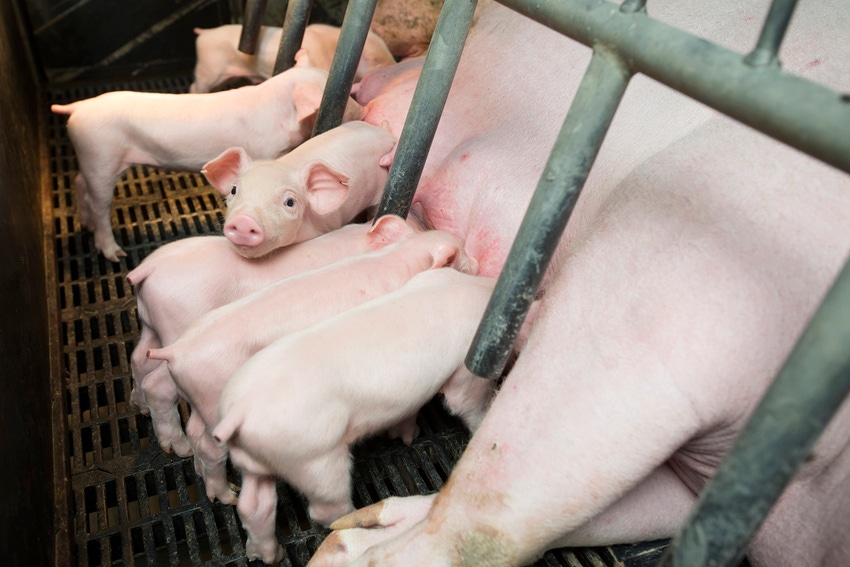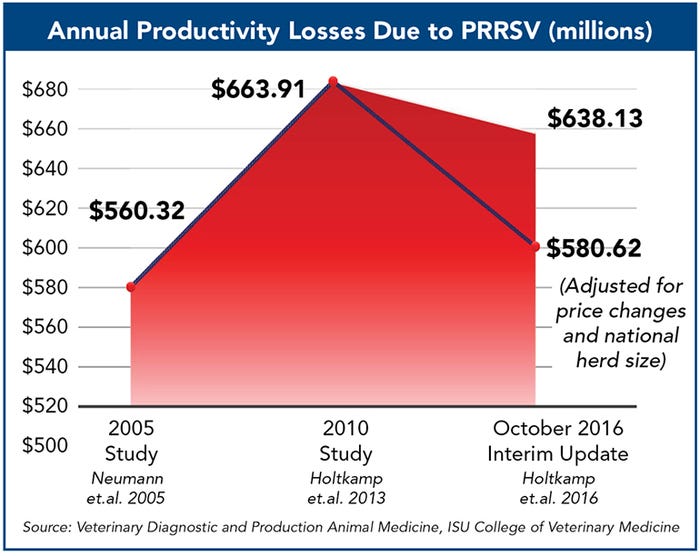Improved biosecurity on individual farms and industry-wide are keys to building confidence that PRRSV elimination efforts can prevent an outbreak or at least delay it for several years.
July 19, 2017

By Marlys Miller, Pork Checkoff Report
Producers and veterinarians are making progress in the battle against porcine reproductive and respiratory syndrome virus. Based on a five-year moving average, annual productivity losses due to PRRSV fell $83.3 million from October 2010 ($663.91 million) to October 2016 ($580.62 million) in a recent interim report.
An ongoing Pork Checkoff PRRS project, conducted through Iowa State University and the University of Minnesota, provides semi-annual updates on the disease’s cost to the U.S. swine herd.
“We have made great progress against this costly disease,” says Jan Archer, immediate past National Pork Board president, Goldsboro, N.C. “Our goal, as outlined in the Pork Board’s strategic plan, is to decrease its impact 20% by 2020 from the 2010 baseline.”
Herd distribution regarding PRRSV status and productivity are what influence the annual losses, says Iowa State University’s Derald Holtkamp, DVM, who directs the study. “All of the gains have come from productivity improvements in PRRS-affected herds, particularly in herds that have not had an outbreak in 12 months,” Holtkamp said.
While more breeding herds are PRRS-positive today, improved biosecurity and herd-health management have contributed to gains. This includes limiting piglet cross-fostering, closing the breeding herd and maintaining immunity through vaccination versus live-virus inoculation.
“Fewer pigs are PRRSV-negative at weaning than in 2010,” Holtkamp says. “To continue the progress made during the past five years, we need to increase efforts to stabilize sow farms so they can wean more PRRSV-negative pigs.”

Still most costly disease
Despite advances made against PRRS, it has not been unseated as the U.S. pork industry’s most costly disease.
“Even at its worst, porcine epidemic diarrhea virus did less damage than PRRSV does year after year,” says Holtkamp, adding that lessons learned from PEDV have helped make progress against PRRSV.
“There’s been a shift in the producer mindset,” Holtkamp says. “Producers are more committed to biosecurity since PEDV, and they’re more convinced that it can make a difference.” Before PEDV surfaced in 2013, PRRS outbreaks affected 30 to 40% of all U.S. breeding herds. After PEDV, it dropped to 20 to 25%.
Greater attention to biosecurity and better sow-farm management has reduced PRRSV’s impact on productivity, but there has been a shift toward control and away from elimination since 2010. With fewer PRRSV-negative breeding herds, progress will require prioritizing elimination.
“Herd immunity wanes over time, and then outbreaks become more severe again,” Holtkamp says. “Considering long-term financial losses, it still pays to work toward elimination.”
Improved biosecurity on individual farms and industry-wide are keys to building confidence that PRRSV elimination efforts can prevent an outbreak or at least delay it for several years. Holtkamp endorses on-farm risk assessments and outbreak investigations to identify weaknesses and prioritize where to allocate resources.
“It comes down to risk/reward trade-offs.” he said.
You May Also Like


